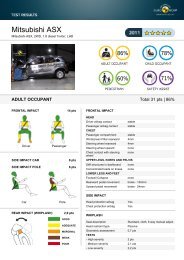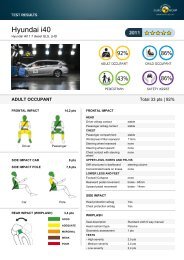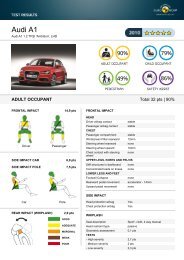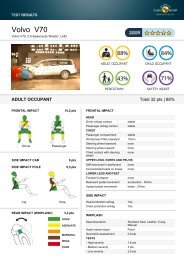Pedestrian Test Protocol - Euro NCAP
Pedestrian Test Protocol - Euro NCAP
Pedestrian Test Protocol - Euro NCAP
Create successful ePaper yourself
Turn your PDF publications into a flip-book with our unique Google optimized e-Paper software.
Version 7.0<br />
March 2013<br />
Release point<br />
h<br />
Impactor in free flight<br />
<br />
75mm<br />
Free flight distance (d)<br />
Figure 24: Droop Compensation<br />
9.5 Ballistic Compensation<br />
There are two procedures which can be used for ballistic compensation, it is at the discretion of<br />
the test house as to the most appropriate method, see Figure 25. The terms used for the<br />
calculations are:<br />
At the release point: At the point of first contact:<br />
u = initial velocity v = impactor velocity (11.1m/s)<br />
= firing angle = direction of impact (0)<br />
d = free flight distance<br />
h = height increase<br />
9.5.1 The first case is where is fixed, and = 0, v = 11.1m/s. The vehicle must be<br />
positioned in relation to the fixed propulsion system, therefore u, d, and h are the<br />
subjects.<br />
9.5.2 Using the following equations find u, d, and h:<br />
v<br />
u <br />
cos( )<br />
2<br />
v<br />
d tan( )<br />
g<br />
2<br />
v 2<br />
h tan ( )<br />
2g<br />
9.5.3 Position the vehicle to be the correct distance away from, and height above the release<br />
point. Proceed to Section 9.5.8.<br />
9.5.4 The second case is where d is fixed, and = 0, v = 11.1m/s. The propulsion system is<br />
positioned and aimed in relation to the vehicle, therefore u, h and are the subjects.<br />
9.5.5 Using the following equations find u, h and :<br />
37
















